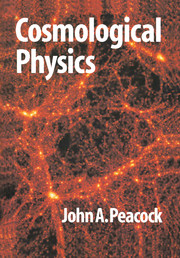Book contents
- Frontmatter
- Contents
- Preface
- Part 1 Gravitation and relativity
- Part 2 Classical cosmology
- Part 3 Basics of quantum fields
- Part 4 The early universe
- 9 The hot big bang
- 10 Topological defects
- 11 Inflationary cosmology
- Part 5 Observational cosmology
- Part 6 Galaxy formation and clustering
- Hints for solution of the problems
- Bibliography and references
- Useful numbers and formulae
- Index
10 - Topological defects
Published online by Cambridge University Press: 05 June 2012
- Frontmatter
- Contents
- Preface
- Part 1 Gravitation and relativity
- Part 2 Classical cosmology
- Part 3 Basics of quantum fields
- Part 4 The early universe
- 9 The hot big bang
- 10 Topological defects
- 11 Inflationary cosmology
- Part 5 Observational cosmology
- Part 6 Galaxy formation and clustering
- Hints for solution of the problems
- Bibliography and references
- Useful numbers and formulae
- Index
Summary
The temperatures and densities of the nucleosynthesis era are remote from everyday experience, but the picture of the big bang up to T ∼ 1010 K stands a fair chance of being correct, since it is based on well-established nuclear physics. The next two chapters will be much more speculative. The frontier of cosmology from the 1980s onwards consisted of looking at exotic physics and asking whether the state of the universe at very high redshift could have differed radically from a simple radiation-dominated plasma. Chapters 10 and 11 look at different aspects of such high-energy phase changes.
Phase transitions in cosmology
There are several phase transitions of potential importance in cosmology that may have left observable signatures in the present. In descending order of energy, these are:
(1) The GUT transition, E ∼ 1015 GeV. Above this temperature, all interactions except gravity had equal strength and the universe had no net baryon number. Below this temperature, the symmetry is broken via the Higgs mechanism so that the gauge group of particle physics degenerates from the grand-unified G to the usual SU(3) ⊗ SU(2) ⊗ U(1) of the standard model. Baryon non-conserving processes can now operate; this may have generated the present-day excess of matter over antimatter.
(2) The electroweak transition, E ≃ 300 GeV. At this energy scale, the Higgs mechanism again breaks the SU(2)⊗U(1) part of the theory to yield the apparently distinct electromagnetic and weak interactions.
[…]
- Type
- Chapter
- Information
- Cosmological Physics , pp. 305 - 322Publisher: Cambridge University PressPrint publication year: 1998



